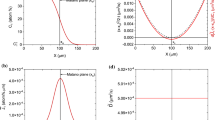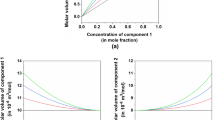Abstract
A new analytical method for computing concentration-dependent interdiffusion coefficients, when a non-uniform solute distribution pre-exists in a substrate prior to diffusion in a binary system, is developed from Fick’s laws of diffusion. The key concept of the new method is validated by experimental data reported in the literature. This new method addresses the limitations of previous analytical techniques such as Boltzmann–Matano, Saucer–Friese, and Sarafianos methods, which are restricted to a single solute concentration profile, with no non-uniform initial solute distribution. The analyses of numerically simulated concentration profiles show that previous standard analytical methods are erroneous when computing the interdiffusion coefficients in binary systems with significant non-uniform initial solute distributions. In contrast, the new analytical method can reliably compute the concentration-dependent interdiffusion coefficient operative between two isothermal concentration profiles obtained at different diffusion times. Practically, this method can be used to extract concentration-dependent interdiffusion coefficients from planar diffusion systems with non-uniform initial solute distribution caused by pre-diffusion or multi-staged diffusion processes.
















Similar content being viewed by others
References
Q. Zhang, and J.-C. Zhao, Extracting Interdiffusion Coefficients from Binary Diffusion Couples Using Traditional Methods and a Forward-Simulation Method, Intermetallics, 2013, 34, p 132–141
F. Sauer, and V. Freise, Diffusion in binären Gemischen mit Volumenänderung, Zeitschrift für Elektrochemie, 1962, 66, p 353–362
C. Wagner, The Evaluation of Data Obtained with Diffusion Couples of Binary Single-Phase and Multiphase Systems, Acta Metall., 1969, 17, p 99–107
L.D. Hall, An Analytical Method of Calculating Variable Diffusion Coefficients, J. Chem. Phys., 1953, 21, p 87–89
T. Ahmed, I.V. Belova, A.V. Evteev, E.V. Levchenko, and G.E. Murch, Comparison of the Sauer-Freise and Hall Methods for Obtaining Interdiffusion Coefficients in Binary Alloys, J. Phase Equilib. Diffus., 2015, 36, p 366–374
N. Sarafianos, An Analytical Method of Calculating Variable Diffusion Coefficients, J. Mater. Sci., 1986, 21, p 2283–2288
D. Ansel, I. Thibon, M. Boliveau, and J. Debuigne, Interdiffusion in the Body Cubic Centered β-phase of Ta–Ti Alloys, Acta Mater., 1998, 46, p 423–430
G.L.E. Gall, and J. Debuigne, Acta Mater., 2000, 35, p 2297–2305
L. Zhu, Q. Zhang, Z. Chen, C. Wei, and G. Cai, Measurement of Interdiffusion and Impurity Diffusion Coefficients in the bcc Phase of the Ti–X (X = Cr, Hf, Mo, Nb, V, Zr) Binary Systems Using Diffusion Multiples, J. Mater. Sci., 2017, 52, p 3255–3268
S.K. Tang: University of Waterloo, 2009.
J. Lienig and M. Thiele: in Fundamentals of Electromigration- Aware Integrated Circuit Design, Cham, Switzerland, 2018, pp. 13–26.
B. Chao, S.H. Chae, X. Zhang, K.H. Lu, J. Im, and P.S. Ho, Investigation of Diffusion and Electromigration Parameters for Cu–Sn Intermetallic Compounds in Pb-free Solders Using Simulated Annealing, Acta Mater., 2007, 55, p 2805–2814
M. Liu, H. Fu, C. Xu, W. Xiao, Q. Peng, H. Yamagata, and C. Ma, Precipitation Kinetics and Hardening Mechanism in Al-Si Solid Solutions Processed by High Pressure Solution Treatment, Mater. Sci. Eng. A, 2018, 712, p 757–764
C. Zhong, F. Liu, Y. Wu, J. Le, L. Liu, M. He, J. Zhu, and W. Hu, Protective Diffusion Coatings on Magnesium Alloys: A Review of Recent Developments, J. Alloys Compd., 2012, 520, p 11–21
W. Chen, Q. Li, and L. Zhang, Resistance of Magnesium Alloys to Corrosion Fatigue for Biodegradable Implant Applications: Current Status and Challenges, Materials (Basel), 2017, 10, p 1–11
E. Kirkendall, L. Thomassen, and C. Uethegrove, Rates of Diffusion of Copper and Zinc in Alpha Brass, Trans. Am. Inst. Min. Metall. Eng., 1939, 133, p 186–203
E.O. Kirkendall, Diffusion of Zinc in Alpha Brass, Trans. Am. Inst. Min. Metall. Eng., 1942, 147, p 104–109
C. Matano, On the Relation Between the Diffusion-Coefficients and Concentrations of Solid Metals, J. Phys., 1933, 8, p 109–111
T. Ahmed, I.V. Belova, and G.E. Murch, Finite Difference Solution of the Diffusion Equation and Calculation of the Interdiffusion Coefficient Using the Sauer–Freise and Hall Methods in Binary Systems, Proc. Eng., 2015, 105, p 570–575
S. Santra, and A. Paul, Role of the Molar Volume on Estimated Diffusion Coefficients, Metall. Mater. Trans. A, 2015, 46, p 3887–3899
M.T. Modes: in Electrochemistry and Corrosion Science, 2006, p. 124.
O. Karabelchtchikova, and R.D. Sisson, Carbon Diffusion in Steels: A Numerical Analysis Based on Direct Integration of the Flux, J. Phase Equilib. Diffus., 2006, 27, p 598–604
O. Karabelchtchikova, and R.D. Sisson, Fundamentals of Mass Transfer in Gas Carburizing, Defect Diffus. Forum, 2007, 266, p 171–80
A.D. Smigelskas, and E.O. Kirkendall, Zinc Diffusion in Alpha Brass, Trans. AIME, 1947, 171, p 130–142
S. Gasparin, J. Berger, D. Dutykh, and N. Mendes, Stable Explicit Schemes for Simulation of Nonlinear Moisture Transfer in Porous Materials, J. Build. Perform. Simul., 2018, 11, p 129–144
O. Olaye, and O.A. Ojo, Leapfrog/Dufort–Frankel Explicit Scheme for Diffusion-Controlled Moving Interphase Boundary Problems with Variable Diffusion Coefficient and Solute Conservation, Model. Simul. Mater. Sci. Eng., 2019, 28, p 1–24
Y. Zhou, W.F. Gale, and T.H. North, Modelling of Transient Liquid Phase Bonding, Int. Mater. Rev., 1995, 40, p 181–196
Acknowledgments
The authors also thank the NSERC of Canada for providing the financial support for the project.
Author information
Authors and Affiliations
Corresponding authors
Additional information
Publisher's Note
Springer Nature remains neutral with regard to jurisdictional claims in published maps and institutional affiliations.
Rights and permissions
About this article
Cite this article
Olaye, O., Ojo, O.A. A New Analytical Method for Computing Concentration-Dependent Interdiffusion Coefficient in Binary Systems with Pre-existing Solute Concentration Gradient. J. Phase Equilib. Diffus. 42, 303–314 (2021). https://doi.org/10.1007/s11669-021-00883-z
Received:
Revised:
Accepted:
Published:
Issue Date:
DOI: https://doi.org/10.1007/s11669-021-00883-z




